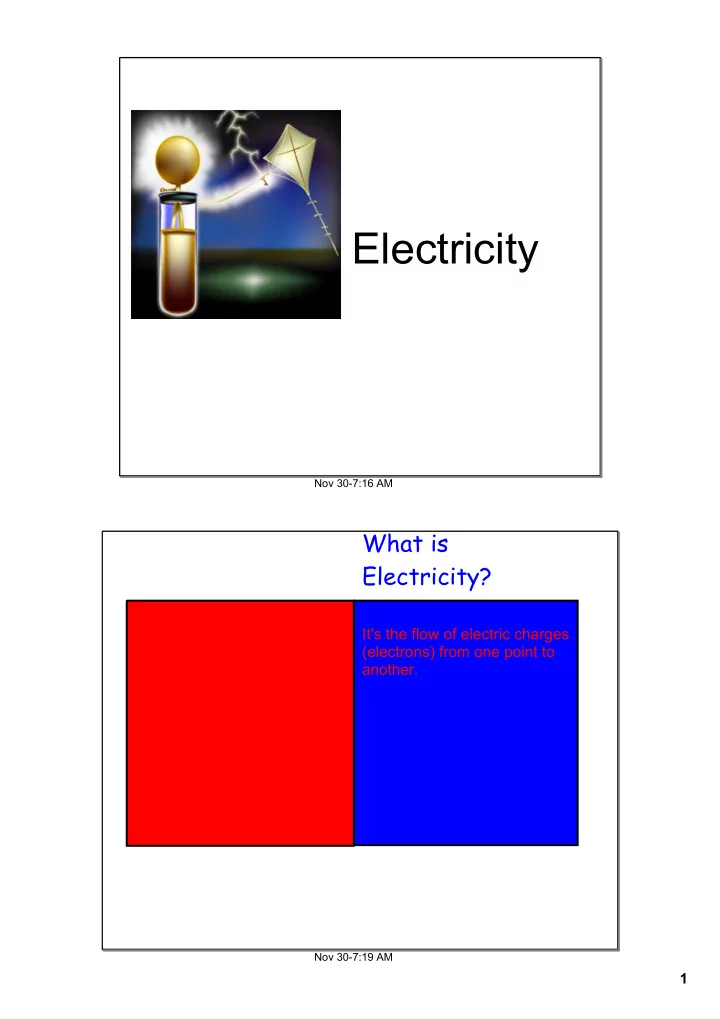

Electricity Nov 307:16 AM What is Electricity? It's the flow of electric charges (electrons) from one point to another. Nov 307:19 AM 1
The law of Charges states that opposite charges attract each other and like or the same charges repel each other . Nov 307:41 AM Draw the law of charges Nov 307:45 AM 2
Why are charges important? They influence different types of electricity like Static Electricity. • Static electricity is the build up of charges on an object. • Static means "stationary" or "not moving" so static electricity is charges staying on an objects surface instead of constantly moving. Nov 307:46 AM We can charge objects using Friction! Friction allows us to "rub" off extra electrons from one surface to another. This transfer is "charging" an object balloons_en.jar Nov 307:53 AM 3
Circuits! A Circuit is a complete, closed path in which electrical charges flow through. The electrical charges start and end at the same point There are 2 types of circuits: Series and Parallel Nov 307:55 AM Series Circuits: In a series circuit, all parts are connected in a single loop. The charges can only flow in one direction. Let's draw a schematic! Nov 308:00 AM 4
Parallel Circuits: Different loads or resistors are wired in separate branches in the circuit, so the electric charges have a choice of which path to take. Let's draw a schematic! Nov 308:02 AM In a series circuit, if one bulb In a parallel circuit, if one goes out: bulb goes out: all the bulbs go out because the the other bulbs will stay lit charges can no longer flow because the charges can flow through the loads back to the through the other path(s) starting point. back to its starting point. Nov 308:04 AM 5
Circuit measurements Current: The rate at which a charge passes a given point. This means it is how many charges pass this point a second. It is measured in Amps (A) Voltage: The difference in energy between 2 points in a circuit and is measured in Volts (V) Resistance: The opposition to the flow of electric charges. Anything in a circuit is a resistor. Nov 308:06 AM Today's Experiment You are going to create several types of circuits. Using the materials provided you will need to create a series circuit and a parallel circuit . For both circuits: you will need 2 batteries and battery holders, a switch, 2 light bulbs, a multimeter, and 4 wires The first circuit you will create is a series circuit with both batteries. After you wire the light bulb, switch, and battery, use the multimeter to observe the current at the light bulb and switch. Next, observe the voltage at both points. Write down these numbers as well as any other observations! Nov 308:10 AM 6
Now add a light bulb in SERIES . Observe the bulbs brightness. What is the current at each light bulb? What is the voltage at each light bulb? Write down any observations and data Now unscrew one light bulb. What happens? Is this what you expected? Now wire the 2nd light bulb in PARALLEL. Observe the bulbs brightness. What is the current at each light bulb? What is the voltage at each light bulb? Write down any observations and data/ Now unscrew one light bulb. What happens? Is this what you expected? Nov 308:15 AM Dec 68:29 AM 7
Recommend
More recommend